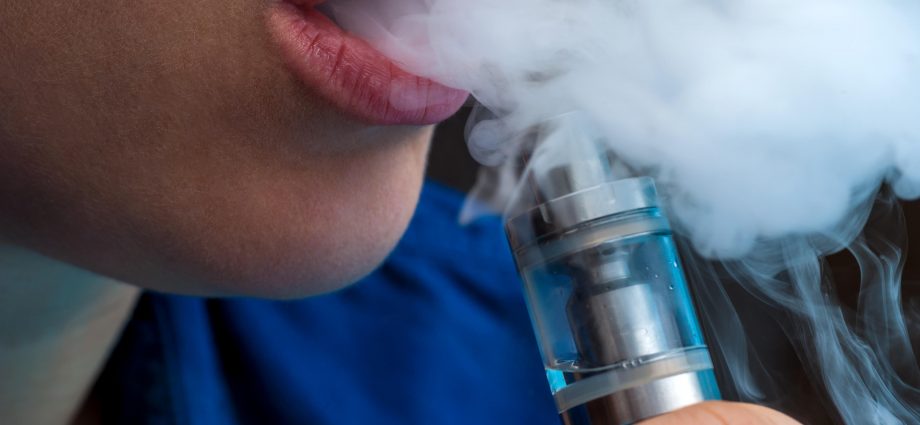THURSDAY, Aug. 17, 2023 (HealthDay News) — Vaping CBD (cannabidiol) is on the rise among middle and high school students, according to a national U.S. survey, and health experts warn there can be serious risks involved.
More than 1 in 5 students who use electronic cigarettes said they had vaped CBD, a component of marijuana that does not get people high the way THC does, according to results of the 2022 National Youth Tobacco Survey. And more than 6% didn’t know whether or not they had vaped CBD.
Hispanic and LGBTQ+ kids are the most likely groups to vape CBD, the survey revealed.
While the authors of the study say CBD is the most popularized non-psychoactive component of cannabis, they add that its use raises several safety concerns, including potential harm to the liver and lungs and possible damage to the male reproductive system.
“The findings suggest that evidence-based educational campaigns, interventions, and public policy changes are needed to reduce the harmful health outcomes possible with vaping CBD among developing youths,” wrote the authors, led by researcher Hongying Daisy Dai, from the College of Public Health at the University of Nebraska Medical Center.
Other specialists are also concerned, and at least one disagrees that CBD is non-psychoactive.
“CBD still has psychoactive properties. It could have potential cardiac, pulmonary and cognitive effects,” said Dr. Scott Krakower, a New York child-adolescent psychiatrist who was not part of the study.
And, he added, all of the chemicals inside a vape aren’t always apparent, especially since the products are almost entirely unregulated by the U.S. Food and Drug Administration.
“I’ve had cases where a vape pen was suspected of being tainted with other substances. Kids think they were ingesting one thing, but it was unclear if it was laced with something else, like cocaine. It’s so hard because if you buy vapes from the dealer instead of from the store, stuff will show up in the urine and the only thing the kid remembers is smoking the vape pen,” Krakower said.
For the study, researchers took a nationally representative sample of around 28,000 American students from the Youth Tobacco Survey conducted from January to May of 2022. Of the 2,448 reported active e-cigarette users, 21.3% said they had vaped CBD, and 6.3% didn’t know whether or not they had vaped CBD.
The findings were published Aug. 16 in JAMA Network Open.
“What we’re learning about vaping CBD or cannabis, whether that’s distillate like wax or it’s the active cannabis — the THC-containing or more the cannabidiol-like CBD — is that, one, young people under-recognize the risks,” said Dr. Diane Tanaka, medical director of the Teenage and Young Adult Health Center at Children’s Hospital Los Angeles.
“Two, they may not even realize, like the study identified, that they’re vaping CBD. They think it’s just probably flavoring and makes a cool vapor that comes out when you use it,” added Tanaka, who was also not part of the study.
“So I think this very much confirms that, yes, more education needs to occur, more sharing with young people, the potential health risks of vaping in general, and then specifically around vaping cannabis or derivatives thereof like CBD,” she added.
The risks of kids vaping CBD may come from both the habit of vaping and from the marijuana itself.
“The evidence is coming out that the younger you are when you start using cannabis or marijuana, the greater the impact we can see on brain development and mood,” said Tanaka.
“So for a 12-year-old using cannabis, it’s riskier than a 25-year-old who’s just started using cannabis,” she explained.
“There also has been some early evidence to show it can decrease or negatively impact memory, which also is going to affect how well kids retain, let’s say, their school information, academics,” Tanaka said. “And there’s concern it actually can negatively change some of the way the neurotransmitters work in the developing brain versus when your brain is fully matured at 25.”
On using e-cigarettes in general, which can contain a myriad of active substances like nicotine and THC as well as secondary harmful ones like carcinogens and heavy metals, Krakower said the effects are also multifold.
“In the worst cases, we’ve had severe irritability, aggression, hypertensive, you know, unable to calm down, questions at some point even if it contributed to psychosis or severe bouts of psychogenic dysphagia [a swallowing disorder],” Krakower said. “I have other cases where they were ingesting so much they couldn’t even quit. They needed the [nicotine] patch, they needed gum. I mean, it’s awful.”
According to the U.S. Centers for Disease Control and Prevention, more than 2.5 million middle and high school kids reported using e-cigarettes in 2022.
More information
For more on e-cigarettes, visit HealthDay’s Wellness Library.
SOURCES: Scott Ira Krakower, DO, associate professor, psychiatry, Zucker School of Medicine at Hofstra/Northwell, and child-adolescent psychiatrist, Glen Oaks, N.Y.; Diane Tanaka, MD, medical director, Teenage and Young Adult Health Center, medical director, Homeless Adolescent and Young Adult Wellness Clinic Medical Director, My Voice Transition Program, attending physician, Children’s Hospital Los Angeles, and clinical associate professor of pediatrics (clinician educator), Keck School of Medicine of USC; JAMA Network Open, Aug. 16, 2023
Copyright © 2025 HealthDay. All rights reserved.

